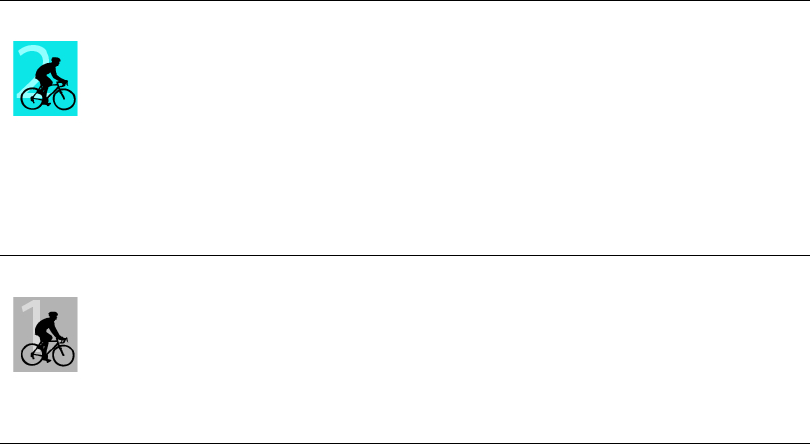
Target zone
Intensity % of
HR
max
, bpm
Example
durations
Training benefit
LIGHT
60–70%
114-133 bpm
60–300
minutes
Benefits: Improves general base fitness,
improves recovery and boosts
metabolism.
Feels like: Comfortable and easy, low
muscle and cardiovascular load.
Recommended for: Everybody for long
training sessions during base training
periods and for recovery exercises
during competition season.
VERY LIGHT
50–60%
104–114 bpm
20–60
minutes
Benefits: Helps to warm up and cool
down and assists recovery.
Feels like: Very easy, little strain.
Recommended for: For recovery and
cool-down exercises throughout the
training season.
HR
max
= Maximum heart rate (220-age). Example: 30 years old, 220–30=190 bpm.
Cycling in sport zone 1 (Very light) is done at very low intensity. The main training principle is that
performance level improves after training during the recovery period, not only during training. You can
accelerate your recovery process with very light intensity training.
Sport zone 2 (Light) is for endurance training, an essential part of any training program. Cycling sessions
in this zone are easy and aerobic. Long-duration training in this light zone results in effective energy
expenditure. Progress will require persistence.
Aerobic power is enhanced in sport zone 3 (Moderate). The training intensity is higher than in sport zones
1 and 2, but still mainly aerobic. Training in sport zone 3 may, for example, consist of intervals
followed by recovery. Cycling in this zone is especially effective for improving the efficiency of blood
circulation in the heart and skeletal muscles.
If your goal is to compete at top potential, you will have to train in sport zones 4 (Hard) and 5 (Maximum).
In these zones, cycling is aerobic, in intervals of up to 12 minutes. The shorter the interval, the higher
the intensity. Sufficient recovery between intervals is very important. The training pattern in zones 4
and 5 is designed to produce peak performance.
When cycling in a certain sport zone, the mid-section of the zone is a good target, but don’t keep your
heart rate at that exact point all the time. Training intensity, recovery level, environmental and other
such factors will all contribute to heart rate responses. It is, therefore, important to pay attention to
subjective feelings of tiredness and to adjust the training program accordingly.
A simple way of making use of the sport zones is making your target heart rate zones. For further
instructions, see Plan your training.
After the session is over exercise duration in the sport zone is displayed. Access the Weekly display for
the sport zones you have been exercising in, and the time spent exercising in one. The Polar ProTrainer
5 software offers up to 10 sport zones to better serve your training needs and heart rate reserve.
OwnZone Training
Your cycling computer automatically determines an individual and safe exercise intensity zone: your
OwnZone. The unique Polar OwnZone defines your personal training zone for aerobic training. The
function guides you through your warm-up, and takes your present physical and mental condition into
account. For most adults, OwnZone corresponds to 65-85% of maximum heart rate
OwnZone can be determined in 1-5 minutes during a warm-up period by cycling, walking, jogging, or
doing some other sport. The idea is to start exercising slowly at a light intensity, and to gradually
increase intensity and heart rate. OwnZone is developed for healthy people. Some health conditions
may cause heart rate variability-based OwnZone determination to fail. These conditions include high
Polar CS400 User Manual 37


















